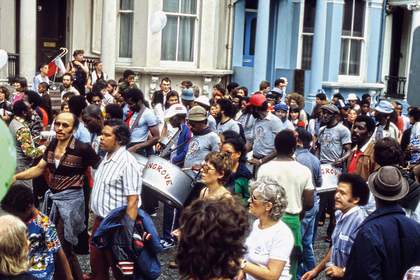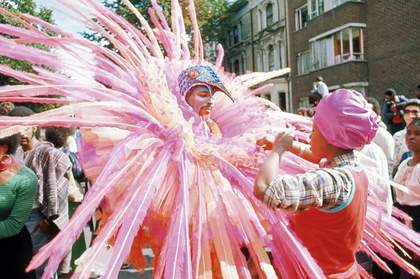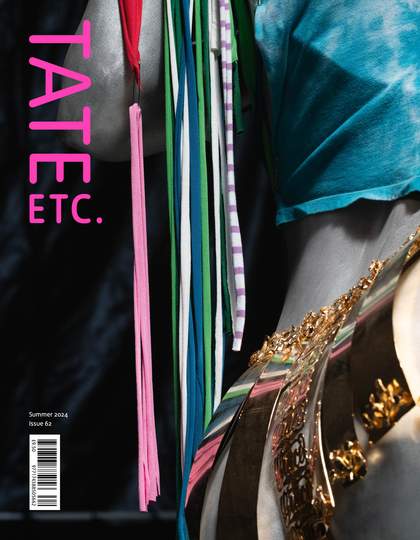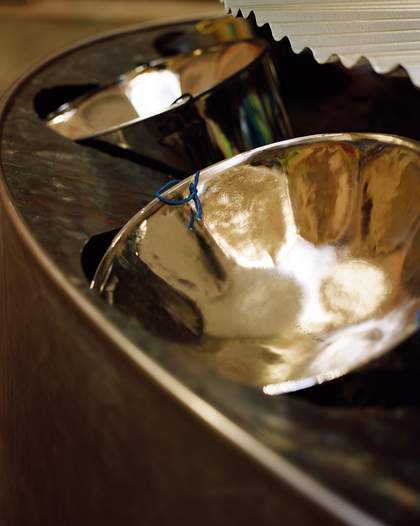
The Mangrove steel band take to the streets for the first time.
Photo by Allan ‘Capitan’ Thornhill, 1980
TATE ETC. What were your very first experiences of Carnival?
MATTHEW PHILLIP My parents immigrated to London in the 1960s. My dad came from Trinidad, and my mum from Ireland. My dad became involved in the Mangrove Community Association and restaurant that was on All Saints Road in Westbourne Park, and later went on to form the Mangrove Steel Band and the Mas [masquerade] band with the activist and civil rights campaigner Frank Crichlow and others.
I remember going to watch the steel band rehearsing when I was very young, and being fascinated. My first memories of the carnival itself were taking part in a Sailor Mas with the steel band – I’ve got a picture somewhere of me standing in front of the Tabernacle in Notting Hill wearing the sailor costume. My dad tells me at my first Carnival I was aged two being pushed by him in a buggy, but I obviously can’t remember that!
ETC. What did it mean to you?
MP I had a sense that there was a deeper message. The themes for the Mas band were related to soldiers in the army, for example, and have some political element. But I wasn’t initially aware of anything other than the fact of a strong culture connecting people, and something important that they were trying to preserve.
ETC. Did you find that your relationship with Carnival changed as you grew up?
MP I began to get more involved in it over time. The two days of Carnival are important, but there’s a whole build-up over weeks and months at the Mas camps where everyone makes costumes and gets ready. It was an education for me, being around people who were creating and discussing the carnival, while also talking about their experiences and what was happening within and without the community.
ETC. When did you make the switch from participant to performer?
MP Eventually, I got involved in the Mangrove Youth Steel Band. We played all the time, in weekly sessions, in competitions – I played at my first Panorama, the national steel band competition, in 1984 – and then for the two days of Carnival. Carnival was a lot smaller then and there wasn’t really a prescribed route. I remember the band would be based outside of the old Mangrove restaurant. Our float would be there and, whenever the guys felt like going around the block, off we’d go, in any direction they felt like, late into the night.

Willie Francis, a percussionist from the Metronomes steel band, performs as The Bird of Paradise Pierrot in a costume designed by Peter Minshall.
Photo by Allan ‘Capitan’ Thornhill, 1974
ETC. Are you still playing?
MP Yes, I still play drums every Tuesday night!
ETC. When did you first begin working for the Carnival in an official capacity?
MP I’ve been in and around the Carnival community in various guises for a number of years. But in 2018, Carnival Village Trust got the opportunity to organise the Carnival in an official capacity, and I was chosen as the first CEO.
You’ve got to remember, however, that Carnival is the community. It’s not one or two people, it is a massive collective effort. We have a board of directors and representatives of the various disciplines of Carnival, but we also have hundreds of performers, dancers, bands, DJs and sound-system organisers, all contributing to the event and how it’s run. It’s like a big patchwork quilt that grows and changes organically because each person, each group, has their own identity, which changes over time. And all these groups have artistic freedom, and mix it up every year. No two carnivals are the same, which is why I think it remains relevant and so popular in the hearts and minds of people.
ETC. What are your ambitions for Carnival – how would you like to see it develop in the future?
MP Our core role in the Carnival office is to manage a safe and spectacular Carnival. Beyond that, we ensure that the wider communities have freedom to input into the event itself. My own artistic output is through Mangrove Steel Band and Mas Band – organising and playing when I can.
ETC. The curators of GRACE, Alvaro Barrington’s Tate Britain Commission, have spoken of the project reflecting carnival as a ‘temporary and joyful break in the social order’ – an opportunity to say what isn’t usually permitted, or to bring unlikely people together.
MP Absolutely. At its root, Carnival is about freedom. The first carnivals in the Caribbean were organised by former enslaved people reclaiming the streets – spaces they hadn’t been allowed in, or welcomed. That idea of freedom is still important to this day, and is similar to what happens in the UK. Carnival brings people from all different walks of life together to celebrate what we have in common. For two days of the year at the end of August, you have these tiny streets in West London filled with people expressing and enjoying themselves, and having a break from day-to-day life.

A reveller wearing a ‘Mas in the Ghetto’ top gets into the mood of Carnival.
Photo by Allan ‘Capitan’ Thornhill
ETC. What do you think of the idea of Carnival coming into an institution like Tate?
MP Carnival on the streets of Notting Hill is about disruption and showing an alternate side to life. I think Alvaro going into Tate Britain, a long-established institution, has the potential to create something quite different, and quite important. Alvaro is a prolific and versatile artist, and he does really value and celebrate Carnival. He’s not just paying homage.
I loved his recent show at Sadie Coles HQ, Grandma’s Land, which recreated aspects of his life in Grenada, and the music and experience of Carnival, while giving space to other artists. He is not creating a version of Carnival, but Carnival itself.
ETC. You have worked with Alvaro before on commissions for Notting Hill Carnival, but also on projects that take Carnival into different settings and different contexts.
MP Yes, exactly. We worked with him on a project for Glastonbury – an area for a static sound system made with oil drums and huge paintings. At night, it was illuminated with writing, saying ‘NHC and Home’. The oil drums were similar to those that were reclaimed by people in Trinidad and Tobago and fashioned into instruments – the original steel pans. Many were painted with images of the sea as a tribute to the Windrush generation. It was like Alvaro was telling a story about their journey to the UK. Notting Hill Carnival was shaped in part by Trinidadian traditions; those members of the Windrush generation reflecting and reminiscing about home, and trying to create that home space within Notting Hill.
ETC. It’s like home, but also a kind of sanctuary.
MP It’s sanctuary and it’s acceptance. Glastonbury is like Carnival in that it brings together so many different people from different backgrounds, but everyone is at ease and, for the most part, smiling and enjoying themselves. I guess in some ways that’s Alvaro’s hope for Tate Britain – trying to create a sense of home and sanctuary.
ETC. Where would you like to see Carnival in 50 years?
MP On the streets of Notting Hill, where it should be, and thriving. The floats might change, the people might change, but Carnival itself is here to stay.
Join us at Tate Britain for the Big Weekender, a programme of events on 3–4 August celebrating all things Carnival, music, community and home, inspired by Alvaro Barrington’s new commission for the Duveen Galleries.
This year’s Notting Hill Carnival will be held on 25–26 August. The photographs reproduced here are taken from Carnival: A Photographic and Testimonial History of the Notting Hill Carnival (Rice N Peas, 2014), edited by Ishmahil Blagrove Jr.
Matthew Phillip is CEO of Carnival Village Trust and Notting Hill Carnival Ltd. He spoke to Tom Avery, Editor, Tate Etc.




